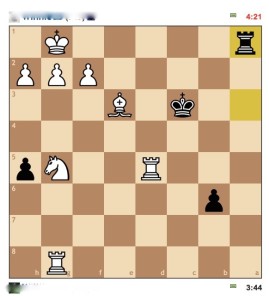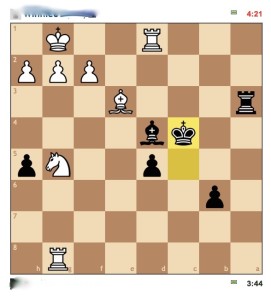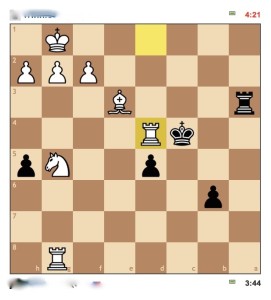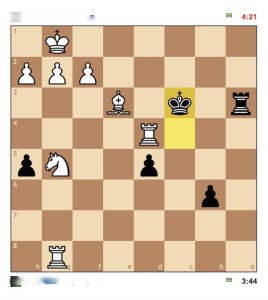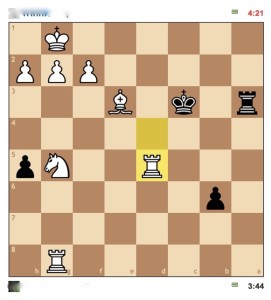Chess Strategy- Capturing A Trapped King For Checkmate
Chess Strategy 101
Capturing A Trapped King for Checkmate
I recently played a game against an opponent online who was fairly skilled in chess. They were playing very well throughout most of the game, and quite frankly, I was making many mistakes.
However, near the end of the chess match, I had a unique opportunity for checkmate, despite being at a major disadvantage pieces wise. However, despite this disadvantage, I was able to still win the game, and so can you.
Today, we’ll break down the final 3 moves of the game for each opponent, learn about looking for a “trapped king” to checkmate your opponent in chess, and what can be learned from this chess match.
Final 3 Moves:
As you can see here, I was great disadvantage in regards to chess pieces. My opponent (white) had a rook and knight advantage, as well as 2 additional pawns, and my King was out in the open. This is not the ideal position to be in.
However, my opponent’s King was trapped by his own pawns (upper left corner), and I had a rook in position to checkmate the King, so long as my opponent’s rook moved from protecting the King.
My opponent moves their bishop to e3, diagonal to mine. (the chessboard letters are in faint letters on the board) I could capture their bishop, and then lose my own from a white pawn capture. However, I was focused on capturing the King. If I captured their bishop, and had their pawn capture my bishop in return, the King would no longer be trapped, and could avoid a rook checkmate. (As you’ll see from the end result).
Final 2 Moves:
My opponent makes a critical mistake, attacking my bishop with their rook. I move my King out of check up to c3. Preparing for my rook on a 3 to place white King in checkmate.
Final Moves: Checkmate
My opponent captures my pawn, (most likely completely unaware their own King is trapped, and assuming they have the game won).
I move my King to a 1. Their King, trapped by their pawns, has no where to move, and the game is now over.
Chess Strategy 101
Lessons to Be Learned From A Trapped King
1. Pay Attention For A Trapped King
It’s fairly common for a less experienced opponent to leave their King trapped, either underestimating your own chess skills, or just not being aware of it (we all make mistakes). Keep an eye out for a trapped King, and act quickly.
2. Never Leave Your King Trapped
Likewise, make sure you never trap your own King, making an easy checkmate for your opponent. As you can see from this game, leaving your King trapped is a critical mistake. With one simple move from the rook, the game was over, despite my opponent having a great advantage over me.
3. Focus On Capturing The King, Not Capturing Chess Pieces.
As covered in Chess Strategy 101, what matters in the game of chess is NOT how many chess pieces have been captured, but whether or not the King is captured. It’s important to understand that even if you have less chess pieces than your opponent, do not feel the game is over.
As you can at the end of the game, my opponent’s 2 to last move was capturing a pawn, instead of continuing to put pressure on my King with either their knight or other rook.
Likewise, if you have an advantage on your opponent, do not make the mistake of thinking the game has been won. Like in any game or sport, it’s not over until it’s over.
4. Use Your Chess Pieces to Your Advantage
While my opponent did many things write in this chess match until the end (and I made many mistakes in this match prior to the end), one critical mistake they made was not utilizing all their chess pieces.
My opponent had another rook on g8. Had this chess piece been utilized, they could very well have secured a win. They also had knight on g5 that could have placed my king in check on their 2 to last move.
5. Don’t Give Up/ Learn From Your Mistakes
As I said before, up until this point, I wasn’t really on my game. I made many mistakes through this game, but continued to play for both the challenge and for more experience to learn from.
As you can see from this particular game, despite being at a disadvantage, I was still able to win the game. (Of course, there are plenty of circumstances where this isn’t the case), but with a few mistakes from your opponent and sharp focus from yourself, it’s always possible to pull through and checkmate the King.
More Chess Strategy 101:
15 Move Checkmate- Live Video & Breakdown
How to Win Chess in 2 Moves (Fool’s Mate)
How to Win Chess in 3 Moves
How to win Chess in 4 moves (Scholar’s Mate)
Chess Strategy 101- 7 Basic Principles For Improving Your Chess Game

